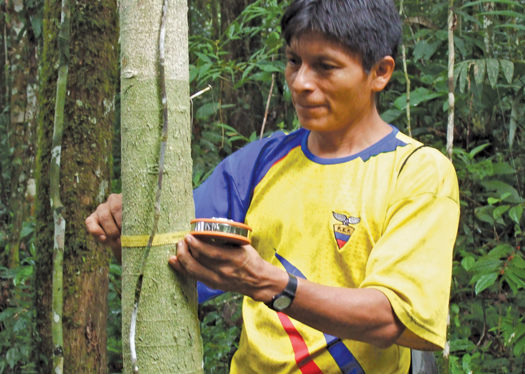
Researcher Abel Monteagudo measures tree in Peruvian rainforest plot. (Photo by Roel Brienen)
The Amazon, the world’s biggest tropical rainforest, is also a crucial carbon sink, soaking up vast quantities of carbon dioxide that would otherwise accumulate in the atmosphere and exacerbate climate change. So when researchers from the University of Leeds and other institutions published a paper in 2016 showing that a severe Amazon-wide drought in 2010 temporarily stopped the vast forest from absorbing carbon, the environmental community took notice.
Drought, the researchers found, not only killed trees, leading to a release of carbon dioxide. It also dramatically slowed photosynthesis, the process by which trees use carbon to grow. During the 2010 drought and more localized ones in 2005 and 2007, one of the forest’s key functions—carbon capture—effectively ceased, an interruption that holds worrisome implications for climate-protection efforts.
Forest composition changing
A study published last November by some of the same researchers adds to the unsettling story. Drought, while impeding carbon sequestration, also has been changing forest composition in the Amazon as moisture-loving tree species die and are replaced with species that can tolerate drier conditions. Disturbingly, that shift has not kept pace with an altered climate. The transition toward more dry-tolerant trees lags significantly behind the rate of climate change, the researchers show.
“Over the last 30 years, we’ve seen the climate in the Amazon get about 36% drier,” says Adriane Esquivel-Muelbert, the lead author of the study and a research fellow at the University of Birmingham and University of Leeds in England. “The move towards trees tolerant of dry conditions has been around 9%.”
Changes in climate, of course, have both global and local causes. Greenhouse-gas emissions have made the world’s climate hotter and, in some cases, drier. But deforestation, which causes the release of carbon dioxide and thus plays a role in heating the planet, also can have direct local effects. For instance, it diminishes the forest’s contribution to rainfall through transpiration, the process by which trees pull moisture from the soil and send it into the atmosphere as water vapor. Tree loss also lessens the land’s ability to retain moisture, reducing the dependability of water sources serving local plants, animals and people.
Deforestation in much of the Amazon, moreover, is worsening after a period in which some progress in slowing the rate of land clearing was being made. According to a preliminary estimate by Brazil’s National Institute for Space Research (INPE) issued in November, deforestation from August 1, 2017 to July 31, 2018 reached 7,900 square kilometers (3,050 sq. miles), the highest figure in a decade.
In that context, the new study’s findings are of particular concern. That’s because the underlying research—done over three decades on over 100 single-hectare (2.5-acre) primary-forest plots in Brazil, Bolivia, Peru, Ecuador, Colombia, Venezuela, French Guiana, and Guyana—occurred in Amazon areas that are still intact. “That makes this all quite scary,” says Esquivel-Muelbert. “We’re seeing forests suffer from anthropogenic effects even in areas where forests have not been chopped down.”
Myriad effects
The tree-composition changes reported in the study have many dimensions. The Amazon transition to dry-tolerant trees of such genera as Brosimum and Pseudolmedia is being accompanied by a shift to larger trees as higher levels of carbon dioxide, crucial to photosynthesis, spur growth. The bigger trunks and leaves, in turn, create a denser forest canopy, depriving the understory of light and leading to the proliferation there of smaller, slower-growth trees.
Still another phenomenon is taking place in the driest parts of the rainforest: the emergence of fast-growing pioneer species—of the genus Cecropia, for instance. But these trees have short life cycles and store less carbon, potentially leaving the forest less effective than it once was as a brake on climate change.
No one can predict the long-term impacts on forest biodiversity, but wet-tolerant Amazon taxa have far greater diversity than dry-tolerant ones. The tree-species shift also could affect insects, including pollinators and animals higher up the food chain. The fact that certain areas of the Amazon are suffering from greater flooding, even as much of the rest of the forest becomes drier, only deepens the uncertainties. Researchers say deforestation must be curbed and biological corridors maintained so tree species can move where the climate suits them.
“Natural corridors allow seed dispersal, especially by animals, so trees can find their climactic niche,” says University of Oxford researcher Jesús Aguirre-Gutiérrez, who was not involved in the study. “They are really important.” A next step, he adds, will be to better understand how the altered forest composition affects everything from carbon fixation to soil erosion and water availability.
“This research shows that forest composition is changing,” Aguirre-Gutiérrez says. “But we also want to know how that will affect the functioning of forest systems.”
- Steve Ambrus
Link to paper on drought impact on forest composition: here